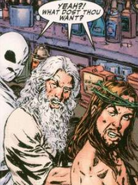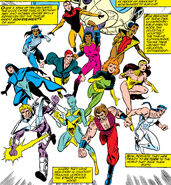History
Origins[]
The Gods of Earth are extra-dimensional races of beings who once existed on Earth in its distant past and are now or were once worshiped as Gods or deities by the different cultures on Earth. It is known they are descended from the primeval Earth-Goddess Gaea and over the years have separated into tribes or pantheons, each pantheon connected to worshipers separated on Earth by either geological, cultural, or environmental boundaries.[citation needed]
The exact origins of the Gods of Earth are lost in antiquity, but it is known that every culture has its own, often contradictory, myths on the creation of the universe. What is known is that soon after the creation of the Earth, the Demiurge, the embodiment of the planet's potential biosphere, seeded it with its own life essence, producing the Elder Gods known as Set, Chthon, and Gaea among others. Most of these deities degenerated into demons, forcing Gaea to have to sire a son, Atum, to destroy most of them, while the few that survived were driven away to nether realms. Atum and Gaea may have fathered the later pantheons of Gods, but this is unrevealed.[4]
Pre-Cataclysmic Age[]
Man later evolved and began worshiping these Gods. Those Gods who existed before the sinking of Atlantis (not all confirmed to be Earth-Gods proper) included Honen/Honan,[5] Hotath,[6] Anu,[7] Zukala,[citation needed] the Woman in the Moon,[citation needed] the Great Scorpion,[8] the White Wolf,[9] Ja-Quari the Tiger God,[citation needed] Baal,[10] Dagon,[citation needed] Crom,[citation needed] Erlik,[11] and many others. Many of these Gods were tutelary, worshiped by isolated cities or regions,[citation needed] avoiding all contact with other Elder Gods except those to which they were immediately related.[citation needed]
Valka achieved prominence circa 30,000 B.C, which lasted at least 12,000 years.[12]
Circa 19,500 BC or earlier, Crom banished the demon Shuma-Gorath. Circa 18,530 BC,[citation needed] Erlik made the Valusian soldier Vonndhar a servant of his.[citation needed]
Around 18,500 BC, the deities who will later become known as the Elder Gods of the Hyborian Age intended to make King Kull of Valusia the vessel of their power, but chose instead to make the immortal cat Sedrick (felinized by the sorcerer Thulsa Doom) the container of their power.[citation needed]
Hyborian Age[]
After the sinking of Atlantis, the Hyborian Age began as gods such as Mitra, Asura, Derkerto, Derketa, Ishtar, Ashtoreth, Astorte, Bel, and even Set from his dimension sought worshippers in the aftermath of the disasters.[citation needed]
However, at some point before the start of the Hyborian Age, the Primal Gods (possibly the same beings as those called the Elder Gods of the Hyborian Age) created the Four Cornerstones of Creation.[citation needed]
Circa 10,500 BC, the Priestess of the Cult of Creation, Princess Noyo of Khitai, fled from Pau Styss the Demon Lord. Battling him, her lords turned her into a mystic wind that drifted away. Circa 10,100 BC a man named Kaleb forcibly left his priestly brotherhood due to his siring a child named Solaise. Working with the Council of Seven, he stole the Child of the Elder Gods. Later regretting his actions, Kaleb's daughter became the host of the Child of the Elder Gods, henceforth unaging. Elsewhere the Primal Gods created a mate for Noyo (who at some point inhabited a Cimmerian village), a man named Laynnen. Later Laynnen and Noyo would face Pau Styss. Even later, the demon known as the Devourer of Souls would gain the power of the Elder Gods of the Hyborian Age from Sedrick and Solaise. Fortunately, his plans saw defeat. Later, Solaise would visit a prince named Conn to bestow on him the Sword of the Elder Gods.[citation needed]
Later, cataclysms ended the Hyborian Age, giving rise to pantheons of interrelated Gods who sought worshipers within their spheres of influence. Some of these Gods, like the Titans, later conceived generations of gods by whom they were supplanted and replaced.[citation needed]
Among the earliest gods still active in the post-Hyborian world are the Sumerian and Egyptian Pantheons. Circa 2950 BC the deity Khonshu opposed Rama-Tut, while Set and Isis appeared to En Sabah Nur, the future Apocalypse. The Asgardians came to be worshiped by the Norsemen, and the Olympians, the successors of the Titans, were worshiped in Greece. Other Gods appeared before each of the great civilizations, looking for followers. In a few places, like Greece, the Eternals were mistaken for the Olympian gods, a situation that the Olympians tolerated most of the time, knowing that the Celestials were watching from afar.[13]
The Gods of Earth have met a few times since 1000 AD, requiring the creation of the Council of Godheads, a group comprised of the godheads of each pantheon on Earth, although this was not always preclusive. Athena has recently appeared to the group in the absence of Zeus.[14] Odin was also impersonated by Loki during another gathering.[15]
As centuries went, the worship of most of these gods died out, being replaced with monotheistic religions like Christianity and Islam, though some were able to maintain their worship. As a result of this, the gods cut ties with Earth and retreated to their respective realms, refusing to interfere in earthly matters, except for some who still wished to help or manipulate humanity.[16][17][18]Powers and Abilities
Powers
- Immortality - Many of the Gods of Earth have enchanted life-spans, while others have extended longevity without being truly immortal.
Abilities
- Allspeak: The Gods of Earth have Allspeak, enabling them to communicate in all of the languages of the Nine Realms, Earth's dialects, and various alien languages.
Average Strength Level
The Earth-Gods have varying level of strength from one race to another, with often a difference between male and female, in favor of the male:
- average male Gods of Earth can lift (press) from 20[19] to around 40 tons.[20]
- average female Gods (Goddesses) can lift (press) from 10[19] to around 35 tons.[20]
Weaknesses
Habitat
Habitat
Gravity
Atmosphere
Miscellaneous
Type of Government
Level of Technology
Cultural Traits
Representatives
Ares, Hercules, Loki, Odin, Thor, Venus, Zeus, etc. see here
Known Pantheons of Earth-Gods[]
| Pantheon | God Realm | Tissue Density | Average Strength (Male) | Average Strength (Female) | Longevity | Notes |
|---|---|---|---|---|---|---|
 Aboriginal Gods |
Alchera | 2.0× denser than humans | 20 tons | 10 tons | True immortals | * Weaker in strength but can navigate Dreamtime with ease |
 Ahau (Mayan Gods) |
Upperworld | 2.5× denser than humans | 25 tons | 20 tons | True immortals | |
 Akua (Oceanic Gods) |
Celestial Hawaiki | 2.0× denser than humans | 20 tons | 10 tons | True immortals | * Weaker in strength but have faster reflexes |
 Amatsu-Kami (Japanese Gods) |
Ama | 2.0× denser than humans | 20 tons | 10 tons | Virtual immortals (slow aging) | * Weaker in strength but have faster reflexes |
 Annunaki (Mesopotamian Gods) |
Dilmun | 3.0× denser than humans | 30 tons | 25 tons | True immortals | |
 Apu (Incan Gods) |
Hanan Pacha | 2.5× denser than humans | 25 tons | 20 tons | True immortals | |
 Asgardians (Norse Gods) |
Asgard | 3.0× denser than humans | 30 tons | 25 tons | Virtual immortals (slow aging) | |
 Daevas (Hindu Gods) |
Nirvana | 3.0× denser than humans | 40 tons | 35 tons | True immortals | |
 Dievas (Russian Gods) |
Svarga | 3.0× denser than humans | 40 tons | 35 tons | True immortals | |
 Diwatas (Philippine Gods) |
Kaluwalhatian | 2.5× denser than humans | 25 tons | 20 tons | True immortals | |
 Ennead (Egyptian Gods) |
Celestial Heliopolis | 2.5× denser than humans | 25 tons | 20 tons | True immortals | |
 Inua (Northern Gods) |
Quidlivun | 3.0× denser than humans | 30 tons | 25 tons | True immortals | |
 Jumala (Finnish Gods) |
Taivas | 3.0× denser than humans | 30 tons | 25 tons | True immortals | |
 Manidoog (Native American Gods) |
Giizhigong | 2.5× denser than humans | 25 tons | 20 tons | True immortals | |
 Olympians (Greek Gods) |
Olympus | 3.0× denser than humans | 30 tons | 25 tons | True immortals | |
| Shin (Korean Gods) | Shinshi | Unknown | Unknown | Unknown | Unknown | |
 Tenger (Mongolian / Turkic Gods) |
Ergenekon | 3.0× denser than humans | 30 tons | 25 tons | True immortals | |
 Tēteoh (Aztec Gods) |
Topán | 3.0× denser than humans | 25 tons | 20 tons | True immortals | |
 Tuatha de Danaans (Celtic Gods) |
Otherworld (Tír na nÓg) |
3.0× denser than humans | 35 tons | 25 tons | True immortals | * Larger but have slightly slower reflexes |
 Fomorians (Celtic Gods) |
Otherworld (Dark Realm) |
3.0× denser than humans | 35 tons | 25 tons | True immortals | |
 Vodū (West African Gods) |
Orun | 2.5× denser than humans | 25 tons | 20 tons | True immortals | |
 Xian (Chinese Gods) |
Ta-Lo | 2.0× denser than humans | 20 tons | 10 tons | True immortals | * Weaker in strength but have faster reflexes |
 Yazatas (Persian Gods) |
Elysium | 2.0× denser than humans | 25 tons | 20 tons | True immortals |
Gods of the Modern Age[]
In the Modern Age, new pantheons spawned from the technological and societal changes of Earth. It is unknown what relation, if any, those gods have with Gaea, and consequently if they can be considered "Earth-Gods".
Other[]
Trivia
- Some deities, such as Valkyrie,[25] Hadari-Yao,[26], Yu Huang,[27] and Stained Glass Scarlet[28] were mortals who apotheosized either as a result of being elevated to divine status by another deity, through being worshiped, or some other means of attaining godhood.
- This applies to alien gods too. For example, the Skrull Gods include an Eternal Skrull and a Deviant Skrull who both ascended into godhood through the truth and the belief of their words.[29]
- Loki suggests that gods are stories that are so good that the universe believes them; thus, they become reality. In other words, it is the mortals who created the gods.[30] The origins of the Tiger God and Dog God support this theory.[31]
- Doctor Nemesis and Mother Righteous have similar theories. Gods are "ideas" and they get power from "belief" and worshippers. Doctor Nemesis wonders if a god like Thor would cease to exist if the idea of "Thor" is wiped from everyone's minds.[32]
- Stained Glass Scarlet described herself as a living story after her transformation into a goddess, and said the change happened because people told her story and prayed to her. Khonshu, a much older god, described himself as a story as well.[28]
- Although they are not actually gods, the Eternals and Deviants are included in Thor & Hercules: Encyclopaedia Mythologica #1.
See Also
- 138 appearance(s) of Gods of Earth
- 1 appearance(s) in handbook(s) of Gods of Earth
- 38 minor appearance(s) of Gods of Earth
- 974 mention(s) of Gods of Earth
- 2 mention(s) in handbook(s) of Gods of Earth
- 260 invocation(s) of Gods of Earth
- 5 image(s) of Gods of Earth
Links and References
- Gods in the Marvel Universe at the Appendix to the Handbook of the Marvel Universe
- Official Handbook of the Marvel Universe (Vol. 2) #5
- Thor & Hercules: Encyclopaedia Mythologica #1
- Official Guide To The Mythological Universe
- Gods (Marvel Comics) at Wikipedia
References
- ↑ 1.0 1.1 Thor & Hercules: Encyclopaedia Mythologica #1 ; Gaea's profile
- ↑ Official Handbook of the Marvel Universe #8 ; The Olympians' profile
- ↑ Thor & Hercules: Encyclopaedia Mythologica #1
- ↑ Thor Annual #10
- ↑ Savage Sword of Conan #14 ; A Kull Glossary: Honen's entry
- ↑ Kull and the Barbarians #3
- ↑ Kull the Conqueror (Vol. 3) #3 ; Dead Men of the Deep
- ↑ Kull the Conqueror #9
- ↑ Savage Sword of Conan #37 ; Sons of the White Wolf
- ↑ Savage Sword of Conan #131 ; Prince of Thieves
- ↑ Thor & Hercules: Encyclopaedia Mythologica #1 ; The Tenger's profile
- ↑ All-New Official Handbook of the Marvel Universe A to Z #3 ; Council of Godheads
- ↑ Official Handbook of the Marvel Universe #12 ; Zeus' profile
- ↑ Incredible Hercules #116
- ↑ Infinity Gauntlet #2
- ↑ Marvel Atlas #1–2
- ↑ Tales to Astonish #75
- ↑ All-New Official Handbook of the Marvel Universe A to Z: Update #3
- ↑ 19.0 19.1 Thor & Hercules: Encyclopaedia Mythologica #1 ; The Aboriginal Gods's, Akua's, Amatsu-Kami's, and Xian's profiles
- ↑ 20.0 20.1 Thor & Hercules: Encyclopaedia Mythologica #1 ; The Daevas', Dievas' profiles
- ↑ Thor & Hercules: Encyclopaedia Mythologica #1 ; Izanagi's profile
- ↑ Thor & Hercules: Encyclopaedia Mythologica #1 ; Balder's profile
- ↑ Thor & Hercules: Encyclopaedia Mythologica #1 ; Heimdall's profile
- ↑ Immortal Thor #9
- ↑ Secret Avengers #14
- ↑ Black Panther #172
- ↑ Thor & Hercules: Encyclopaedia Mythologica #1 ; Yu Huang's profile
- ↑ 28.0 28.1 Moon Knight (Vol. 9) #8
- ↑ Incredible Hercules #120
- ↑ Loki: Agent of Asgard #17
- ↑ Doctor Strange (Vol. 6) #17
- ↑ Legion of X #2






